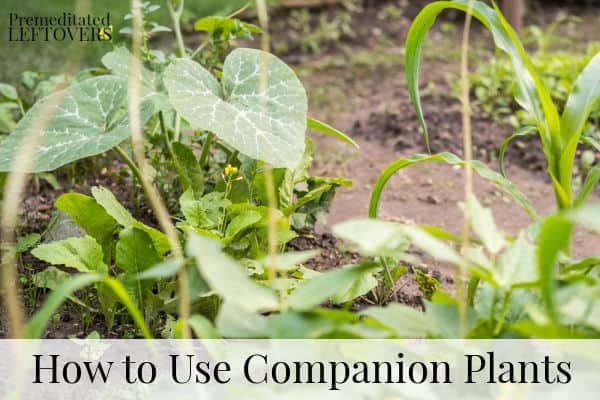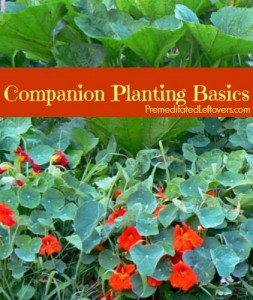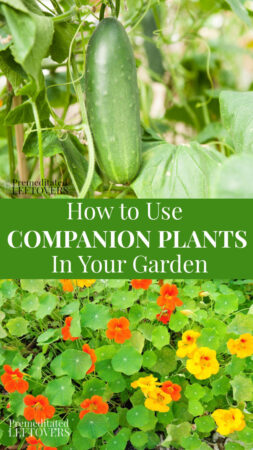Here’s how to use companion plants in the garden and a list of good companion planting combinations.

Just like with people, plants have their best friends – you know, those other plants that they like to grow old next to. When you grow certain plant combinations together they have surprising powers to help each other grow and thrive in the garden.
Companion planting works in a few different ways. For instance, tall plants provide shade for sun-sensitive shorter or even vining plants. Companion plants can also prevent pest problems. Plants like onions and marigolds repel a lot of different pests and other plants like Nasturtiums can lure them away from more desirable plants. Another great example of companion planting is attracting beneficial insects like butterflies and bees to the yard by planting butterfly bush or trumpet vines.
How to Use Companion Plants in Your Garden

Corn and Green Beans:
One of the oldest companion plantings is with corn and beans. The green beans grow up the corn stalks keeping them off the ground and the beans attract beneficial insects that prey on corn pests. A beautiful friendship was born!
Cucumbers and Nasturtiums:
Both plants love to vine out and attract many pests. Nasturtiums are great in salads and have a peppery taste – they also are one of the biggest pest attractors in a garden. They are great to grow with cucumbers so the insects will eat the nasturtiums and leave the cucumbers alone.
Roses and Chives:
Gardeners have planted garlic with rose bushes for hundreds of years. Garlic repels pests that eat the rose petals. Garlic chives are also a good repellent and I love them because their white and purple blooms look great at the base of the rose bush.
Tomatoes, Cabbage & Dill:
Tomatoes are a natural repellent to the diamondback moth larvae, which are huge caterpillars that chew large holes in cabbage 
Radishes and Spinach:
Plant radishes among spinach plants to lure leafminers away from the spinach. Since the leafminers don’t do damage to the radish itself, just its leaves, this is a great compromise in the garden.
Potatoes and Sweet Alyssum:
One of the best smelling plants in any garden is sweet alyssum. Its tiny flowers attract many beneficial insects. Plant sweet alyssum beside potatoes, or on the edges if growing in a container, and let it spread. The potatoes grow pest-free underneath the ground and you get a wonderfully scented garden all year long.
These are just a few of the best companion planting combinations, but there are many more. Learning companion planting combinations will help ensure a garden working together and producing beautiful flowers and a bounty of fruits and vegetables. You can learn more about companion plants in The Complete Guide to Companion Planting, which is available at most libraries.
More Gardening Tips
- How to Start Square Foot Gardening
- DIY Frugal Cloche
- Homemade Rabbit Repellent
- Tips for Attracting Bees to your Garden
- Quick and Easy Compost Pile Using Hay Bales
- How to Extend Your Growing Season with a Container Garden
- Get More from Your Square Foot Garden with Succession Planting
Kristi Trimmer is currently running half marathons across the U.S. and blogging about her journey. At the beginning of 2012 she couldn’t run across the parking lot and in 2013 she ran 10 half marathons. Follow her journey on DragonflyRunning.com.


MPaula says
I hope to have a big vegetable garden this year. I am in a new location and don’t think there has been a garden here for years. Companion gardening makes so much sense and easier as well as better for all living things.
I just checked the catalogue of my local library. The one you suggested is available as an ebook! There is another book about the subject on the shelf. I reserved that one so I will have 2 resources.
Catherine Smith says
It’s always nice to find yet another young organic gardener. I would suggest you dig a little deeper about using companion plants in your garden. Many herbs make great insect repellers. Radishes can be used through out your garden. They are in many ways a “throw-away” plant. If you interplant with radishes, they normally take the first “hit” from insect pests, because they germinate so quickly thus allowing your other vegetables time to germinate with fewer problems.
If you have problems with Japanese beetles, plant several bunches of 4 O’Clocks will away from your other plants. JB’s love them and they are highly toxic to the beetles. We use both Milky Spore and beneficial nematodes to help control the JBs.
Karen @TheMissingNiche says
We have a huge garden but have never used companion plants. Never even heard the word until now! Printing this off for my husband, he loves finding new information that can make him a better “farmer”.